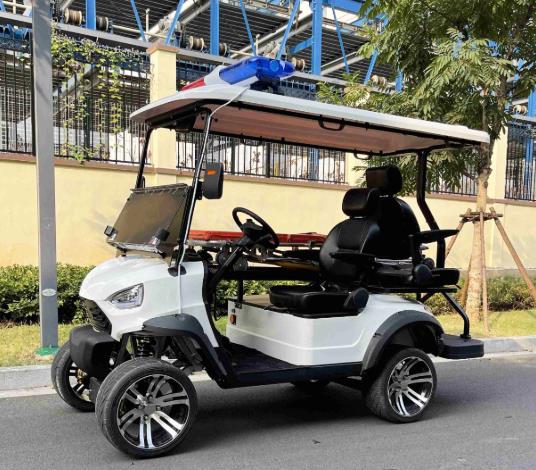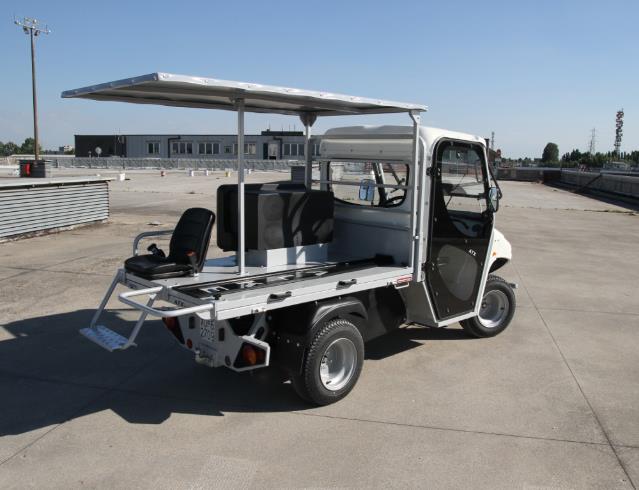Content Menu
● Introduction to Electric Ambulance Carts
● Potential Drawbacks
>> 1. Limited Infrastructure
>> 2. Geographic Isolation
>> 3. Resource Constraints
>> 4. Harsh Weather Conditions
>> 5. Higher Initial Costs
● Case Studies and Innovations
>> Electric Golf Cart Ambulances
>> Video: Electric Golf Cart Ambulance in Kenya
>> Mini Electric Ambulances vs. Golf Cart EMS Vehicles
● Potential Solutions for Rural Areas
>> Partnerships and Collaborations
>> Technological Innovations
● Conclusion
● FAQs
>> 1. What are the primary challenges faced by electric ambulance carts in rural areas?
>> 2. How can the infrastructure challenges be addressed?
>> 3. What role do technological innovations play in enhancing electric ambulance carts?
>> 4. Are there any cost-effective alternatives for rural areas?
>> 5. How important is community engagement in the implementation process?
Electric ambulance carts have emerged as a promising alternative for emergency medical services, particularly in confined or hard-to-reach areas. These carts offer several benefits, including zero emissions, low noise levels, and cost-effectiveness. However, despite their advantages, there are several potential drawbacks to consider when using electric ambulance carts in emergency situations.
Introduction to Electric Ambulance Carts
Electric ambulance carts are designed for short-range transportation within specific environments such as hospitals, resorts, or small communities. They are equipped with essential medical equipment and can be customized to meet specific needs, such as carrying stretchers or providing basic life support systems. These carts are ideal for navigating through crowded spaces or narrow paths where larger vehicles cannot reach.

Potential Drawbacks
1. Limited Infrastructure
One of the primary challenges facing electric ambulance carts is the lack of charging infrastructure, particularly in rural areas. The absence of a comprehensive charging network can significantly hinder the operational capacity of these carts, as they require frequent charging to remain functional. This limitation can lead to delays in medical care, potentially jeopardizing emergency responses.
Infrastructure Development Strategies:
To address this issue, governments and private entities can collaborate to establish a network of charging stations along rural routes. This could include fast-charging stations that can quickly replenish the batteries of electric ambulance carts, ensuring they are always ready for use.
2. Geographic Isolation
Rural areas are often characterized by vast distances and challenging terrain, which can complicate navigation and increase response times. Electric ambulance carts, with their limited range, may struggle to cover these distances effectively. This can be particularly problematic in emergencies where timely medical intervention is critical.
Technological Innovations:
Advancements in battery technology and charging speed can enhance the range and efficiency of electric ambulance carts. For instance, improvements in battery capacity could allow these carts to travel longer distances without needing to recharge, making them more suitable for rural environments.
3. Resource Constraints
Rural communities typically have fewer resources, including limited access to advanced medical equipment and a smaller workforce of trained emergency responders. This scarcity can exacerbate the challenges faced by electric ambulance carts, as they may not be equipped with the necessary medical supplies or staffed by adequately trained personnel.
Community Engagement:
Educating local communities about the benefits and limitations of electric ambulance carts can foster support and cooperation. Community members can be involved in planning and implementing these services, ensuring that they meet local needs and are well-integrated into existing emergency response systems.
4. Harsh Weather Conditions
Rural areas are often exposed to harsh weather conditions, which can affect both the performance of electric vehicles and the accessibility of charging infrastructure. Extreme temperatures, heavy rainfall, or snow can reduce the efficiency of electric ambulance carts and make charging stations less accessible.
Adaptation Strategies:
Implementing weather-resistant designs and ensuring that charging infrastructure is robust against extreme weather conditions can help mitigate these challenges.
5. Higher Initial Costs
Implementing electric ambulance carts requires significant upfront investment, which can be a barrier for rural communities with limited budgets. The cost of purchasing the carts, establishing charging infrastructure, and training personnel can be prohibitive, making it difficult for these communities to adopt this technology.
Cost-Effective Alternatives:
Solar-powered ambulances can be a cost-effective alternative, especially in areas with abundant sunlight and limited access to electricity.

Case Studies and Innovations
Electric Golf Cart Ambulances
In Kenya, a hospital has successfully implemented an electric golf cart ambulance for transporting patients within the hospital premises. This initiative has been praised for its efficiency and environmental benefits, highlighting the potential of electric ambulance carts in specific settings.
Mini Electric Ambulances vs. Golf Cart EMS Vehicles
Mini electric ambulances offer superior medical equipment storage and all-weather operation, while golf cart EMS vehicles excel in maneuverability and cost-effectiveness. The choice between these vehicles depends on specific operational requirements and the typical emergency scenarios encountered.
Potential Solutions for Rural Areas
Partnerships and Collaborations
Forming partnerships between local governments, private companies, and non-profit organizations can help secure funding and expertise for implementing electric ambulance carts. These collaborations can facilitate the development of necessary infrastructure and provide access to advanced technologies that might otherwise be unaffordable.
Technological Innovations
Advancements in battery technology and charging speed are crucial for enhancing the range and efficiency of electric ambulance carts. Ultra-fast charging systems can be deployed at strategic locations to ensure that these vehicles are always operational.
Conclusion
Electric ambulance carts present both opportunities and challenges in emergency medical services. While they offer benefits such as reduced emissions and cost-effectiveness, they also face limitations like limited infrastructure and geographic isolation. Addressing these challenges through infrastructure development, technological innovations, and community engagement is essential for the successful integration of electric ambulance carts into emergency response systems.

FAQs
1. What are the primary challenges faced by electric ambulance carts in rural areas?
The primary challenges include limited infrastructure, geographic isolation, resource constraints, harsh weather conditions, and high upfront costs.
2. How can the infrastructure challenges be addressed?
Infrastructure challenges can be addressed through collaborative efforts between governments, private entities, and local communities to establish a robust charging network.
3. What role do technological innovations play in enhancing electric ambulance carts?
Technological innovations, such as advancements in battery technology and charging speed, can significantly improve the range and efficiency of electric ambulance carts.
4. Are there any cost-effective alternatives for rural areas?
Yes, solar-powered ambulances can be a cost-effective alternative, especially in areas with abundant sunlight and limited access to electricity.
5. How important is community engagement in the implementation process?
Community engagement is crucial as it fosters support and cooperation, ensuring that electric ambulance carts meet local needs and are well-integrated into existing emergency response systems.




















































